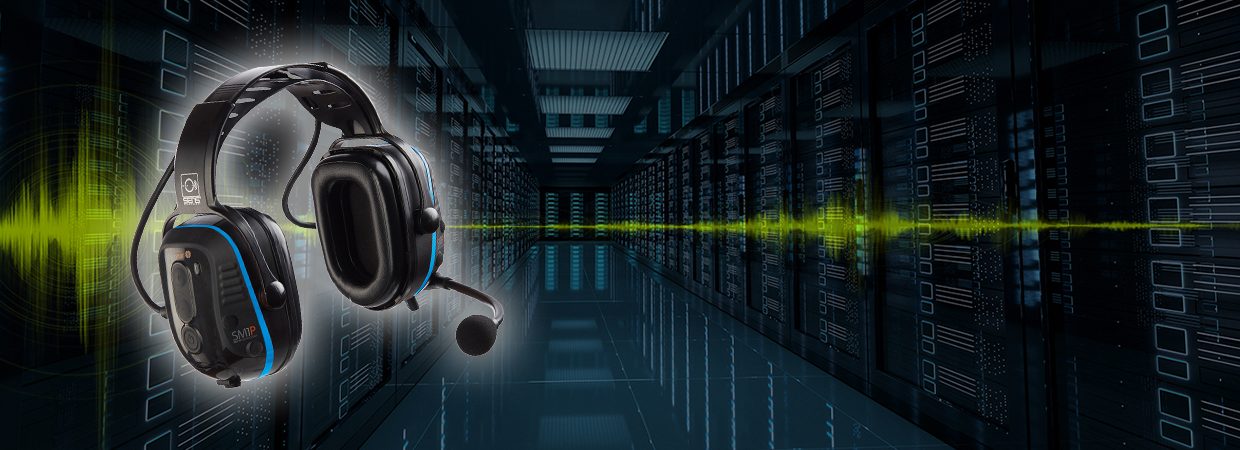- Home
- Blog
- High-Noise Communication
- Data Centers: Communication Not Allowed Here?

Data Centers: Communication Not Allowed Here?
There have been recent articles and scientific research into the noise trends within data centers. Generally, data center managers have taken the position that noise is an acceptable part of the job. However as the industry trends move towards the adoption of high-density equipment and data center consolidation, not only do potential hearing hazards warrant a closer look to protect data center employees, but how do those employees communicate above the noise?
Because systems within data centers vary from large to small, noise levels also vary. As the systems become more concentrated and dense and additional servers are added, more sophisticated equipment is required to cool the system. The addition of fans, additional power supplies, and other equipment simply adds to the “Whoosh” noise levels (“Whoosh” noise refers to the sound of fans running and the humming of power supplies). Constant exposure to these noises should be an area of concern and monitored.
Don’t provide hearing protection at the expense of allowing for communication between employees and with others outside the data center
For instance, say an employee needs to troubleshoot an issue within the data center that requires over-the-phone vendor assistance. Removing hearing protection is dangerous, and the person on the other line may have a hard time hearing the data center employee due to external noise. Many data center employees say that they now take cell phone calls outside the data center so both parties can hear one another, then go back in to work on the equipment. Imagine the productivity gains if the data center employee could use a headset that not only protects their hearing but is connected via Bluetooth® to their cell phone, which also filters outside noise so the person on the other end can hear as well. Instead of having to run outside, place a call, run inside and perform the task, run back outside to place another call, etc., all can be done with the employee in the data center in front of the hardware in question.
If face-to-face or near-range communication within and around the data center is the most important, two-way radio headsets may be the solution.
How long and how loud can we listen to sound without risking hearing damage?
Damage risk criteria provide the basis for recommending noise exposure limits based on noise level and exposure time. OSHA and NIOSH criteria are shown in Figure 1.
 The issue at hand is that most data centers simply are not measuring noise levels. Based on research Sensear has conducted, the average noise level around the server areas of a data center can be up to 92dB(A) and within the server racks noise levels can reach up to 96dB(A). Given that OSHA’s noise threshold for mandatory hearing protection is based on exposure to noise levels exceeding 85dB(A) for over an eight-hour time period, the noise levels within a data center are within the “danger zone” for Noise-Induced Hearing Loss.
The issue at hand is that most data centers simply are not measuring noise levels. Based on research Sensear has conducted, the average noise level around the server areas of a data center can be up to 92dB(A) and within the server racks noise levels can reach up to 96dB(A). Given that OSHA’s noise threshold for mandatory hearing protection is based on exposure to noise levels exceeding 85dB(A) for over an eight-hour time period, the noise levels within a data center are within the “danger zone” for Noise-Induced Hearing Loss.
For more information on hearing loss within data centers, check out this recent TechRepublic article.
We all know that communication is critical. In addition, hearing loss is cumulative…and totally preventable. Investment in communication solutions with hearing protection enables unencumbered communications while looking out for the hearing of your most valuable asset – your employees.
There are many solutions on the market today, from simple earplugs to sophisticated wireless communications headsets that allow for clear communication in person and on the phone which minimizes background noise. If you’d like to explore hearing protection for your employees, feel free to contact Sensear. Our specialists would be happy to help!






